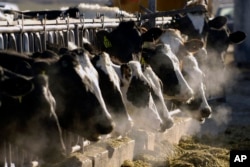The United States plans new rules for the movement of dairy cows between states because of concerns about a bird flu outbreak.
The virus is called Type A H5N1. It has been found in over 30 different groups of cows across eight states.
Some inactive markers of the virus have been found in milk sold in stores. Inactive markers mean the virus is dead and cannot harm humans who drink the milk.
The concern is that the virus could mutate, or change. It could then possibly spread from cows or other animals to humans. Experts, however, believe the risk of that is low.
After April 29, cows must have been tested and found to not have the virus before they are permitted to be moved between states.
The virus has been known by scientists to circulate among wild birds. It appears in other animals if they eat sick birds. Some animals that live near the sea have tested positive for the virus, including harbor seals and polar bears. Animals that eat grasses, such as cows and goats, have only recently been found to have the virus.
Richard Webby is an influenza expert at St. Jude’s Children’s Research Hospital in Tennessee. He said flu viruses are known for adapting to spread among new animals. Finding the virus in dairy milk raises concerns that it could spread to people, Webby said.
Scientists confirmed the virus in cows in March after farmers said their cows were sick. They said the animals’ symptoms included tiredness and low milk production. Some farmers said the milk the sick cows produced was thick and yellow.
Matthew Aliota is an animal medicine researcher at the University of Minnesota. He said finding the inactive virus in the milk “suggests this has been going on longer, and is more widespread, than we have previously recognized.”
The U.S. Department of Agriculture recently sent out new genetic information about the virus.
Michael Worobey is an evolutionary biologist with the University of Arizona. He said the federal agency information makes him think the virus moved from birds to cows late in 2023.
Worobey said the virus likely spreads among the cows due to contact with milking machines, trucks or the shoes of farm workers. It then moves from cow to cow before making its way back to birds. Worobey said birds tested on the same farms as sick cows have a form of the virus with “clear mammalian adaptations.” In other words, the virus shows signs of changing before infecting the bird populations.
Scientists say the best way to keep the virus from spreading to more cows, and possibly humans, is to test cows as often as possible and follow their movements.
Thomas Friedrich is a virology expert at the University of Wisconsin’s animal medical school. “We need to be able to do greater surveillance so that we know what’s going on.”
Worobey said testing for active virus is one thing. But the tests must also look for antibodies, or evidence of past infections.
“That is a really accessible and quick way to find out how widespread this is,” he said.
Scientists are working to be sure that heating up the milk before it is put into containers for humans to drink is enough to kill the virus. The process is called pasteurization. The U.S. Food and Drug Administration (FDA) will have more information about that soon.
Right now, the FDA recommends humans to avoid raw or unpasteurized milk. Farm workers are also being told to wear masks, wash their hands and change their work clothes often, Aliota said.
The U.S. Centers for Disease Control and Prevention said 23 people have been tested for the virus so far. One person has tested positive for a mild eye infection. CDC officials are watching for signs of sickness in 44 other people who were in contact with infected animals.
David O’Connor is a virus expert at the University of Wisconsin-Madison. He said that knowing about the virus should not make humans “change anything about how (they) live their daily lives.”
But he said humans should have “increased awareness that something is happening.”
I’m Dan Friedell. And I’m Ashley Thompson.
Dan Friedell adapted this story for Learning English based on a report by The Associated Press.
_______________________________________________
Words in This Story
dairy –adj. cows that are raised for their ability to produce milk
marker –n. evidence of something existing
adapt –v. to change in response to external conditions
symptom –n. a change in the body that shows a disease is present
evolutionary –adj. describing someone who studies how something changes over time
surveillance –n. watching over something to look for changes
We want to hear from you. Are you worried about bird flu spreading from cows to humans?












Forum